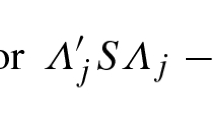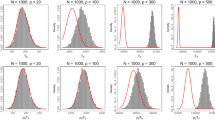Abstract
When the factor analysis model holds, component loadings are linear combinations of factor loadings, and vice versa. This interrelation permits us to define new optimization criteria and estimation methods for exploratory factor analysis. Although this article is primarily conceptual in nature, an illustrative example and a small simulation show the methodology to be promising.
Similar content being viewed by others
References
Bentler, P.M., & Kano, Y. (1990). On the equivalence of factors and components. Multivariate Behavioral Research, 25, 67–74.
de Leeuw, J. (2004). Least squares optimal scaling of partially observed linear systems. In K. van Montfort, J. Oud, & A. Satorra (Eds.), Recent developments on structural equation models: theory and applications (pp. 121–134). Dordrecht: Kluwer Academic. See also http://preprints.stat.ucla.edu, Preprint #360.
Guttman, L. (1956). Best possible systematic estimates of communalities. Psychometrika, 21, 273–285.
Harman, H.H. (1976). Modern factor analysis (3rd ed. Revised). Chicago: University of Chicago Press.
Jennrich, R.I. (2002). A simple general method for oblique rotation. Psychometrika, 67, 7–20.
Johnstone, I.M., & Lu, A.Y. (2009). On consistency and sparsity for principal components analysis in high dimensions. Journal of the American Statistical Association, 104(486), 682–693.
Mulaik, S.A. (2010). Foundations of factor analysis (2nd ed.). Boca Raton: Chapman & Hall/CRC.
Nadler, B. (2008). Finite sample approximation results for principal component analysis: a matrix perturbation approach. Annals of Statistics, 36(6), 2791–2817.
Schönemann, P.H. (1966). A general solution of the orthogonal Procrustes problem. Psychometrika, 31, 1–10.
Shapiro, A. (1984). A note on the consistency of estimators in the analysis of moment structures. British Journal of Mathematical and Statistical Psychology, 37, 84–88.
Shen, H., & Huang, J.Z. (2008). Sparse principal component analysis via regularized low rank matrix approximation. Journal of Multivariate Analysis, 99(6), 1015–1034.
Slutsky, E. (1925). Über stochastische Asymptoten und Grenzwerte. Metron, 5(3), 3–89 (in German)
Witten, D.M., Tibshirani, R., & Hastie, T. (2009). A penalized matrix decomposition, with applications to sparse principal components and canonical correlation analysis. Biostatistics, 10(3), 515–534.
Author information
Authors and Affiliations
Corresponding author
Rights and permissions
About this article
Cite this article
Bentler, P.M., de Leeuw, J. Factor Analysis via Components Analysis. Psychometrika 76, 461–470 (2011). https://doi.org/10.1007/s11336-011-9217-5
Received:
Revised:
Published:
Issue Date:
DOI: https://doi.org/10.1007/s11336-011-9217-5




